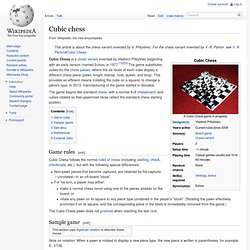

Cubic chess. Cubic Chess is a chess variant invented by Vladimír Pribylinec beginning with an early version (named Echos) in 1977.[1][2][3] The game substitutes cubes for the chess pieces, where the six faces of each cube display a different chess piece (pawn, knight, bishop, rook, queen, and king).

This provides an efficient means (rotating the cube on a square) to change a piece's type. In 2013, manufacturing of the game started in Slovakia. The game begins like standard chess, with a normal 8×8 chessboard, and cubes rotated so that uppermost faces reflect the standard chess starting position. Game rules[edit] Shogi. Shogi (将棋, shōgi?) (/ˈʃoʊɡiː/, Japanese: [ɕo̞ːɡi] or [ɕo̞ːŋi]), also known as Japanese chess or the Generals' Game, is a two-player strategy board game in the same family as Western (international) chess, chaturanga, makruk, shatranj and xiangqi, and is the most popular of a family of chess variants native to Japan. Shōgi means general's (shō 将) board game (gi 棋). Go (game) Go originated in ancient China. Archaeological evidence shows that the early game was played on a board with a 17×17 grid, but by the time the game had spread to Korea and Japan, in about the 5th and 7th centuries AD respectively, boards with a 19×19 grid had become standard.[6] The first 60 moves of a Go game, animated.
This particular game quickly developed into a complicated fight in the lower left and bottom. Go is an adversarial game with the objective of surrounding more territory than one's opponent.[2] As the game progresses, the board gets divided up into areas of territory, as outlined by groups of stones. These areas are then contested in local battles, which are often complicated, and may result in the expansion, reduction, or wholesale capture and loss of the contested area.